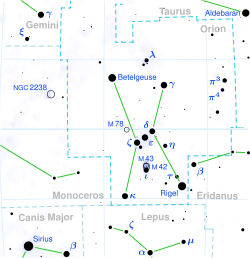オリオン座ウプシロン星
| オリオン座υ星 υ Orionis | ||
|---|---|---|
| 星座 | オリオン座 | |
| 見かけの等級 (mv) | 4.62[1] | |
| 変光星型 | ケフェウス座β型?[2] | |
| 位置 元期:J2000.0 | ||
| 赤経 (RA, α) | 05h 31m 55.86019s[3] | |
| 赤緯 (Dec, δ) | −07° 18′ 05.5371″[3] | |
| 視線速度 (Rv) | 17.4 km/s[3] | |
| 固有運動 (μ) | 赤経: -0.10 ミリ秒/年[3] 赤緯: -4.87 ミリ秒/年[3] | |
| 年周視差 (π) | 1.14 ± 0.25 ミリ秒[3] | |
| 距離 | 1,200 光年[注 1] (366 ± 24 パーセク[4]) | |
| 絶対等級 (MV) | -3.22[5] | |
オリオン座υ星の位置(丸印)
| ||
| 物理的性質 | ||
| 半径 | 5.0 R☉[5] | |
| 質量 | 17.2 M☉[5] | |
| 表面重力 | 20 G[4][注 2] | |
| 自転速度 | 20 ± 2 km/s[4] | |
| スペクトル分類 | O9.7 V[6] | |
| 光度 | 28,000 L☉[5] | |
| 表面温度 | 33,400 ± 200 K[4] | |
| 色指数 (B-V) | -0.26[1] | |
| 色指数 (U-B) | -1.07[1] | |
| 色指数 (R-I) | -0.26[1] | |
| 年齢 | 4.5 ×106 年[7] | |
| 他のカタログでの名称 | ||
| オリオン座36番星, BD-07 1106, HD 36512, HIP 25923, HR 1855, SAO 132222[3] | ||
| ■Template (■ノート ■解説) ■Project | ||
オリオン座υ星(υ Orionis、υ Ori)は、オリオン座にある恒星である。青白い主系列星で、視等級は4.62、太陽系からはおよそ1,200光年離れた位置にある[1][4]。変光星として確定してはいないが、ケフェウス座β型変光星ではないかといわれている[2]。
名称
[編集]オリオン座υ星は、オリオン座ι星の南にあり、バイエルの『ウラノメトリア』では、オリオン座e星(オリオン座29番星)と共に、オリオンの右足に位置している[8]。フラムスティード番号では、36番が付与されている[3]。「サビット」(ﺛﺎﺑﺖ、Thabit)という固有名も持つとされるが、アメリカのアマチュア博物学者アレンによれば、バリットが著した『宇宙の地理学』の星図にその名前が記述されているものの、そもそもの起源は不明である[9]。なお、アラビア語に「変わらないもの」を意味する、Al Thabitという言葉は存在する[9]。
特徴
[編集]
スペクトル型
[編集]1943年以来、オリオン座υ星は、MK分類でB0 V型星の標準星として用いられてきた[11]。しかし、オリオン座υ星のスペクトル型をO9 V型やO9.5 V型とした例もあり、銀河系内のO型星カタログでは、O9.7 V型と定義してその標準星としている[12][13][6]。
変光
[編集]1981年、オリオン座υ星に周期的な吸収線スペクトルの形状変化が見つかった。詳しく調べると、周期およそ12時間の非動径脈動が発生しているものと考えられ、ペルセウス座53番星に代表される、ゆっくり脈動するB型星(SPB)の一つではないかと考えられるようになった[13]。
一方で、測光観測の結果からは、オリオン座υ星がケフェウス座β型である可能性が指摘された[14]。変光星総合カタログの変光星分類によると、ケフェウス座β型の一部がSPBであると分類されており、オリオン座υ星は同カタログでは、新しい変光星候補としてケフェウス座β型に分類、収録されている[15][2]。
位置
[編集]オリオン座υ星の年周視差は、ヒッパルコス衛星による測定で、1.14±0.25ミリ秒と求められており、それを距離に換算すると、地球からおよそ2,900光年となる[3]。一方で、減光を基に推定した距離はおよそ1,670光年、スペクトルから推定した距離はおよそ1,190光年と、手法によって結果のバラつきが大きい[12][4]。
オリオン座υ星は、オリオン座OB1アソシエーションcの一員とされる[16]。
脚注
[編集]注釈
[編集]出典
[編集]- ^ a b c d e Hoffleit, D.; Warren, W. H., Jr. (1995-11), “Bright Star Catalogue, 5th Revised Ed.”, VizieR On-line Data Catalog: V/50, Bibcode: 1995yCat.5050....0H
- ^ a b c Samus, N. N.; et al. (2009-01), “General Catalogue of Variable Stars”, VizieR On-line Data Catalog B/gcvs, Bibcode: 2009yCat....102025S
- ^ a b c d e f g h i “ups Ori -- Variable Star”. SIMBAD. CDS. 2018年1月30日閲覧。
- ^ a b c d e f Nieva, María-Fernanda; Przybilla, Norbert (2012-03), “Present-day cosmic abundances. A comprehensive study of nearby early B-type stars and implications for stellar and Galactic evolution and interstellar dust models”, Astronomy & Astrophysics 539: A143, Bibcode: 2012A&A...539A.143N, doi:10.1051/0004-6361/201118158
- ^ a b c d Nieva, María-Fernanda; Przybilla, Norbert (2014-06), “Fundamental properties of nearby single early B-type stars”, Astronomy & Astrophysics 566: A7, Bibcode: 2014A&A...566A...7N, doi:10.1051/0004-6361/201423373
- ^ a b Sota, A.; et al. (2011-04), “The Galactic O-Star Spectroscopic Survey. I. Classification System and Bright Northern Stars in the Blue-violet at R ~ 2500”, Astrophysical Journal Supplement 193 (2): 24, Bibcode: 2011ApJS..193...24S, doi:10.1088/0067-0049/193/2/24
- ^ Tetzlaff, N.; Neuhäuser, R.; Hohle, M. M. (2011-01), “A catalogue of young runaway Hipparcos stars within 3 kpc from the Sun”, Monthly Notices of the Royal Astronomical Society 410 (1): 190-200, Bibcode: 2011MNRAS.410..190T, doi:10.1111/j.1365-2966.2010.17434.x
- ^ Bayer, Johann (2010-01-20), Ioannis Bayeri Rhainani I.C. Uranometria, Linda Hall Library
- ^ a b Allen, Richard Hinckley (1963), Star Names -- Their Lore and Meaning, Dover Books, p. 318, ISBN 0-486-21079-0
- ^ “Wide-field view of part of Orion in visible light”. ESO. 2018年5月18日閲覧。
- ^ Garrison, R. F. (1994), A Hierarchy of Standards for the MK Process, Astronomical Society of the Pacific Conference Series, 60, p. 3-14, Bibcode: 1994ASPC...60....3G
- ^ a b Underhill, A. B.; et al. (1979-11), “Effective temperatures, angular diameters, distances and linear radii for 160 O and B stars”, Monthly Notices of the Royal Astronomical Society 189 (3): 601-605, Bibcode: 1979MNRAS.189..601U, doi:10.1093/mnras/189.3.601
- ^ a b Smith, Myron A. (1981-08), “Nonradial pulsations in the zero-age main-sequence star upsilon Orionis (O9.5 V)”, Astrophysical Journal 248 (1): 214-221, Bibcode: 1981ApJ...248..214S, doi:10.1086/159145
- ^ Sterken, C.; Jerzykiewicz, M. (1993), “β Cephei stars from a photometric point of view”, Space Science Reviews 62 (1-2): 95-171, Bibcode: 1993SSRv...62...95S
- ^ “GCVS Variability Types and Distribution Statistics of Designated Variable Stars According to their Types of Variability”. Sternberg Astronomical Institute. 2018年2月24日閲覧。
- ^ Warren, W. H., Jr.; Hesser, J. E. (1977-06), “A photometric study of the Orion OB 1 association. I - Observational data”, Astrophysical Journal Supplement Series 34: 115-206, Bibcode: 1977ApJS...34..115W, doi:10.1086/190446


![{\displaystyle \log g[{\mbox{cgs}}]=4.30}](https://wikimedia.org/api/rest_v1/media/math/render/svg/dde6006402e813ba055b2212dfc8b883713a6a0f)